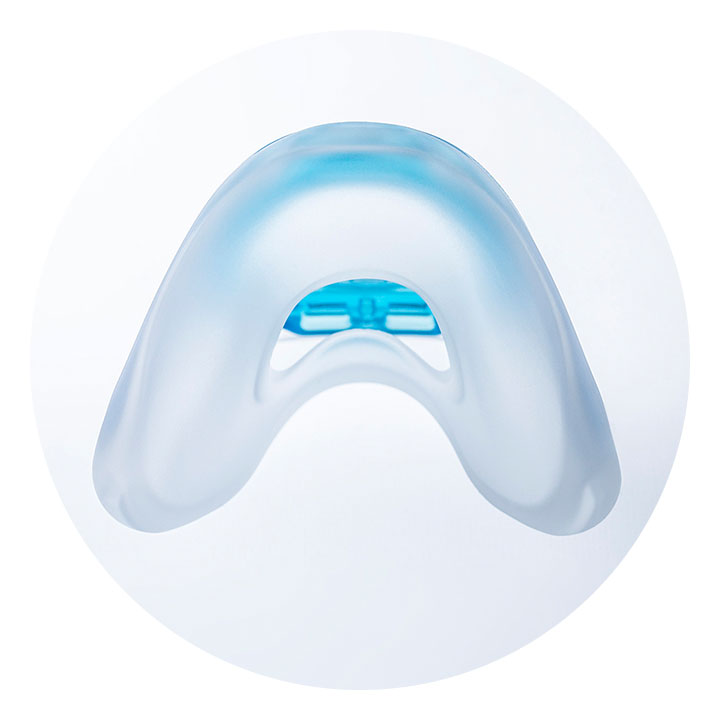What are my CPAP mask options?
There are four mask categories for you to consider – full face, nasal, nasal pillows and oral. Each one has common design elements, especially when it comes to the shape of the mask cushion and where it sits on the face. Masks within the same category can often look similar for this reason.
Why are there different mask types?
Simply put, there are many different mask designs to meet the many different needs of therapy users, e.g., a side-sleeper who breathes through his or her nose on a lower pressure therapy may have different needs to a mouth breathing, active sleeper who requires a higher therapy pressure.
Gain insight into the different mask types, and find out which mask will work best for you.
Full-face CPAP masks cover the mouth and nose. They can also sit under the nose and cover the mouth.
Nasal
Generally, nasal CPAP masks either cover the nose or sit under the nose like a cradle to rest on the area above the upper lip.
Where comfort, seal optimization and ease of use combine
F&P Nova Micro™
nasal pillows mask
MicroPillows™. Less is best™.1
Our smallest and lightest mask yet.2 Featuring the soft MicroPillows™ cushion, it is designed for patients looking for a compact mask that will provide them with a natural sleep experience without compromising on stability and performance.
Mask technology that provides breathability, adaptability and stability.

F&P Eson™ 2
nasal mask
Confidence comes easy
VisiBlue™ highlights assist with fitting, disassembly and reassembly.

F&P Solo™
nasal and nasal
pillows mask
F&P Solo is the world’s first AutoFit™ mask. It simplifies mask usage like no other, using ground-breaking headgear technology. Simply stretch to fit and touch to adjust.
F&P Brevida™
nasal pillows mask
Built for comfort
Adjustable headgear that delivers an individual fit for enhanced therapy comfort.
Looking for ease of use? This mask has been designed to fit like a cap – it couldn't be easier.
F&P Evora™ Full
compact
full-face mask
The F&P Evora Full mask delivers full performance with minimal contact, allowing you to move and sleep freely without compromise.
Features to look for in a CPAP mask
When it comes to CPAP masks, there are several qualities to look for that the best masks share. These include a dynamic cushion that will not easily dislodge if you move around as you sleep. Materials that are soft, breathable, and stretchy help deliver on comfort and support therapy compliance, while adjustable straps provide a customized fit.

Minimalistic design
A light mask with an under-the-nose cushion is a more compact, simplistic therapy approach. This style will appeal to you if you suspect you may feel claustrophobic with fuller face masks.
Soft and flexible materials
Mask and cushion fabrics that are gentle on your skin are less likely to leave marks on your face. They tend to be a lot more flexible to your movement while you sleep.
Breathable and cooling
If you sweat a lot during sleep, consider opting for CPAP mask fabrics that dissipate heat.
Adjustable fit
Mask-wearing compliance begins with a comfortable mask. Being able to adjust your mask to better conform to your facial features will help ensure the mask cushion stays in place and that you will be consistent with the therapy.
Freedom of movement
If you are an active sleeper, look for a CPAP mask that has a minimal size featuring flexible tubing that will not hinder your movements. Rigid tubing may also shunt your mask out of position while you sleep.
Quiet
Comfort isn’t only about how it feels, but how well you sleep. A quieter device will help you do just that. Most CPAP noise is rated at 30 decibels, which is likened to the sound of a whisper.

F&P, Nova Micro, Solo, Evora, Brevida, Vitera, Eson2, Simplus and AutoFit are trademarks of Fisher & Paykel Healthcare Limited. For patent information, see www.fphcare.com/ip
* We refer to CPAP in this instance, but this may also include other positive airway pressure device modes such as APAP or Bilevel. Masks must be used with a PAP device to deliver therapy.




